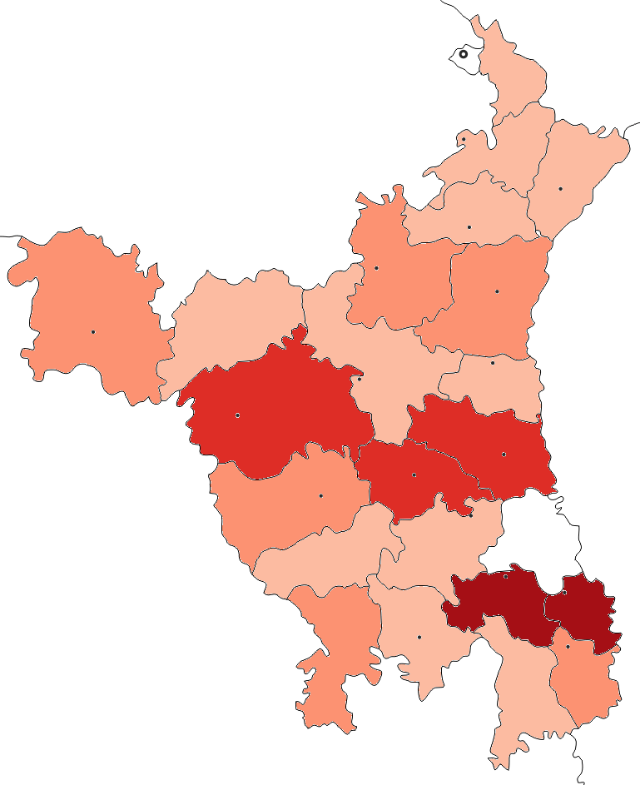By: Dr. Satyavan Saurabh
Haryana was carved out of Punjab on 1st November 1966 as the 17th Indian state. There are various interpretations about the origin of the name Haryana. In ancient times this region was known as Brahmavarta, Aryavarta, and Brahmopadesha. These names are based on the emergence of the Brahma-Bhagwan on the land of Haryana; the abode of the Aryans and the home of the teachings of Vedic cultures and other rites. Its other names Bahudhanyak and Bahudhan suggest Haryana as the land of plenty of food grains and immense wealth. Haryana is located in North West India between 27°39’N to 30°35’N latitude and 74°28’E to 77°36’E longitude and with an altitude of 700-3600 feet above sea level. Haryana’s capital, Chandigarh, shared by its neighbouring state Punjab, is designed by Swiss-born French architect, Le Corbusier. In 44,212 sq km, Haryana covers 1.34% of the geographical area of India.
The area comprising the present-day state of Haryana was ceded to the British East India Company in 1803. In 1832 it was transferred to the then North-Western Provinces of British India and in 1858 Haryana became part of Punjab. Due to the repressive policy of the British government, there was no significant development in the field of education, trade, industry, means of communication, and irrigation in this region. As a result, it remained backward during the 19th century. The union between Haryana and Punjab was peculiar, mainly due to religious and linguistic differences between the two regions: Punjabi-speaking Sikhs of Punjab, compared to Hindi-speaking Hindus of Haryana. With the change of capital from Calcutta to Delhi on December 12th 1911, the Haryana region was further separated. In the 1920s, some changes in the Delhi district were made by the Muslim League and the people of the area, the Commissioner of Delhi, Sir J P Thomson was recommended. In 1928, the all-party conference in Delhi again demanded the expansion of the boundaries of Delhi. In addition, the movement for a separate state of Haryana was led by Lala Lajpat Rai and Asaf Ali, both prominent figures in the Indian national movement, as well as Neki Ram Sharma, who developed the concept of an autonomous state headed a committee.
In the Second Round Table Conference in 1931, Sir Geoffrey Corbert, then Financial Commissioner to the Government of Punjab and Secretary of the Indian delegation to the Round Table Conference, suggested the reorganization of the boundaries of Punjab and the separation of Ambala Division from Punjab. In 1932, Deshbandhu Gupta stated that “the Hindi-speaking region had never been a part of Punjab”. For the development of this region, it needed to be separated from Punjab and amalgamated with Delhi, Rajasthan, and parts of its surroundings. A new state should be created. The demand for the creation of Greater Delhi or Vishal Haryana was raised by Mahatma Gandhi, Motilal Nehru, Asaf Ali, Sir Chhotu Ram, and Thakur Das Bhargava; Haryana remained a part of Punjab after independence in 1947 but as a separate state. The demand for separate states – supported by both Hindus and Sikhs – continued, and did not subside. The movement gained momentum, reaching its full intensity in the early 1960s.
Finally, with the passage of the Punjab Reorganization Act (and by the earlier recommendations of the States Reorganization Commission), Haryana became the 17th state of India, separated from Punjab in 1966, on the recommendation of the Sardar Hukam Singh Parliamentary Committee. The constitution of this committee was announced in Parliament on 23rd September 1965. Acting on the recommendation of the Hukum Singh Committee on 23rd April 1966, the Government of India appointed Justice J C for Partition and Partition. Shah commission was established under the chairmanship of Shah. The boundaries of Punjab and Haryana were established keeping in mind the language spoken by the people. The commission gave its report on 31st May 1966. According to this report, the erstwhile districts of Hisar, Mahendragarh, Gurgaon, Rohtak, and Karnal were to become part of the new state of Haryana. In addition, the tehsils of Jind (District Sangrur), Narwana (District Sangrur), Narayangarh, Ambala, and Jagadhri were also to be included.
The city of Chandigarh and a Punjabi-speaking area of Rupnagar district were made a union territory, serving as the capital of both Punjab and Haryana. According to the Rajiv-Longowal agreement, Chandigarh was to be transferred to the state of Punjab in 1986, but the transfer was delayed and has not been executed so far. The period of instability in Haryana came to an end with the establishment of the rule of the East India Company in 1803. But the people of Haryana did not accept the new masters and revolted against the British irrespective of caste and religion. The Sikh chiefs of Ambala, Karnal, and Thanesar were the first to oppose the Company rule. The Muslim Bhatti Rajputs of western Haryana organized against the British under the leadership of Zabita Khan of Sirsa and Rania and Khan Bahadur Khan of Fatehabad. In November 1809, Colonel Adams was sent with a large detachment to attack Fatehabad, Sirsa, and Rania and emerged victorious in all battles during the campaign.
The Second Anglo-Sikh War (1848–49) was fought between the Sikh Empire and the British East India Company and resulted in the Battle of Gujarat on 21st February 1849, in which the British defeated the Sikhs. As a result, on 2nd April 1849, he declared Punjab as a new province of British India. It included most of Haryana, while the rest was ruled by the princely states of Loharu, Nabha, Jind, and Patiala. The Thanesar state was seized by the British in 1850 and most of the Sikh chiefs were reduced to the status of general vassals. The British then resorted to the methods of merger and consolidation. The bugle of the First War of Independence in 1857 was sounded for the first time by the people of Haryana at Ambala on May 10th, 1857, about nine hours before the outbreak of Meerut. Rao Tula Ram in Ahirwal, Ghafoor Ali and Harsukh Rai in Palwal, Dhanu Singh in Faridabad, Nahar Singh in Ballabhgarh, etc. were important leaders of the rebellion in Haryana. Many battles were fought by the rulers of the princely states and also by the peasants. Some of the most important battles were fought in Sirsa, Sonipat, Rohtak, and Hisar, the famous Battle of Chormar was fought in Sirsa. (The author is a Research Scholar, poet, independent journalist, and columnist)







